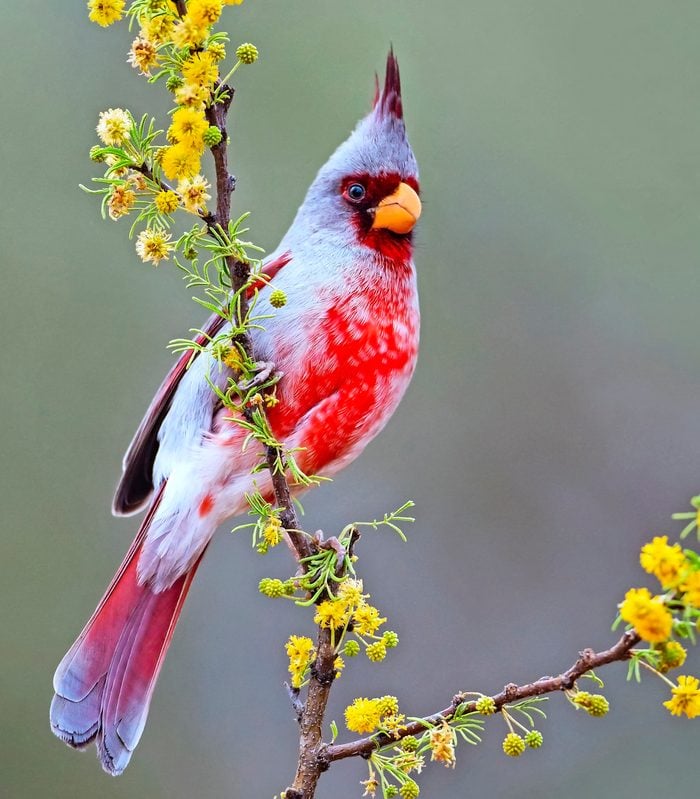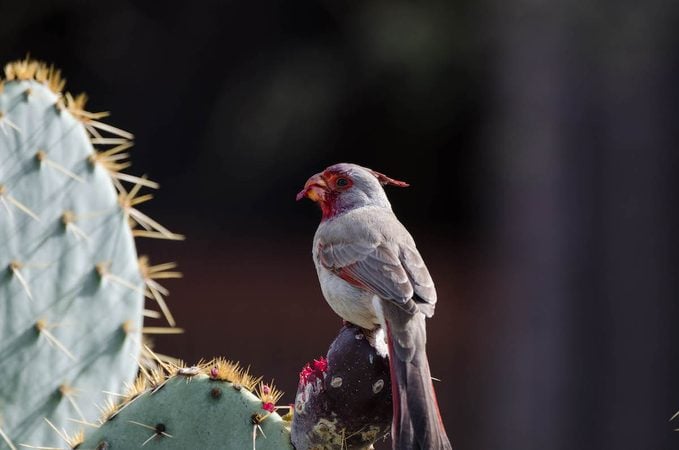Meet the Pyrrhuloxia: Desert Cardinal of the Southwest
Updated: Mar. 18, 2022

Learn all about the pyrrhuloxia, or desert cardinal, a bird found in the Southwest. Experts describe what this species looks like and how to attract them.
Think of a pyrrhuloxia as a southwestern desert cardinal. The name pyrrhuloxia combines the scientific terms for bullfinches and crossbills. Though not related to those species, the pyrrhuloxia has a very similar-looking bill. The bird is actually in the Cardinalis genus, with the more widespread and familiar northern cardinal.
What Does a Pyrrhuloxia Look Like?
The pyrrhuloxia is a favorite of Brad Brockman, a Wild Birds Unlimited store owner in Tucson, Arizona.
“They have such an exotic look,” he says, “almost parrotlike because of the shape of their beaks.” A long, thin, wispy crest helps give the species a particularly whimsical look.
The slate gray birds have varying amounts of red in their plumage. In addition to the crimson highlights in the crests, wings and tails of female birds, males also show red in both their faces and bellies.
Discover interesting facts about cardinals.
Pyrrhuloxia Range
The species is a year-round resident in central Mexico and north into the southwestern United States from roughly Phoenix, Arizona, to Corpus Christi, Texas. It tends to prefer drier habitats like thorn scrub, mesquite and upland desert areas. Meet other desert birds; the verdin bird, an energetic southwestern flier; and the phainopepla bird, a glossy black flycatcher.
See our tips for birdwatching in different bird habitats.
Pyrrhuloxia Calls and Songs
Boundary lines are established with vocalizations reminiscent of a cardinal’s pure repetitive whistle (learn what a cardinal’s call sounds like). Brad notes that the two species have a similar sound, but to his ear, pyrrhuloxia calls have a hollow and piercing quality to them.
Discover the top songbirds in America.
Pyrrhuloxia Nest
During the breeding season, male and female pyrrhuloxias create territories. Males still maintain boundaries after females settle in and build cup-shaped nests during the breeding season. Like cardinals, the female will sometimes sing from the nest while incubating a clutch of two to four eggs. By late summer and into the winter, the aggressively defended territorial perimeters are loosened.
Although some sources mention huge winter flocks, Brad has never encountered these congregations. Instead, he often sees small numbers of the species visiting backyard bird feeders.
Check out 6 proven ways to attract cardinals.

How to Attract and Feed Pyrrhuloxias
Unsurprisingly, the feeding habitats of pyrrhuloxias mirror cardinals. Check out the best cardinal bird feeders and birdseed. Platforms, trays and ground feeding are all good options to allow these songbirds to feed.
Sunflower and safflower seeds are a traditional food choice, but the species eats a variety of things, according to Brad. “I have seen them stick their faces right into an orange,” he says.
A pyrrhuloxia will also take peanuts, mealworms and even jelly. Natural food sources include seeds from grasses and shrubs, cactus fruits and various insects. Consider putting out a birdbath to provide drinking water and a place for them to take a quick dip in the desert heat.
Psst—here’s 11 of the best birdbaths to attract birds.




















